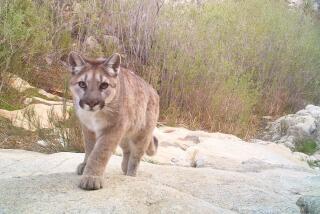Editorial: Rat poison is killing California’s mountain lions. We need to act

L.A. Times Today airs Monday through Friday at 7 p.m. and 10 p.m. on Spectrum News 1.
Rats multiply by the millions, transmit horrible diseases and are just about the last thing you’d want to see in your kitchen, attic, garage or office. Densely populated cities with steady supplies of trash are havens for rats. Los Angeles City Hall had an infestation so bad that officials considered ripping up all the carpeting. Exterminating rats is big business.
But the war on rats has caused some alarming collateral damage: the poisoning of wildlife.
Numerous chemical pesticides are used to kill rats, the most toxic and fastest-acting being second-generation anticoagulant rodenticides. A rat ingests this type of chemical and bleeds to death. One helping of the poison is enough to kill it, but the toxin lives on for months. So there lies the rat, dead, or dying and lethargic, easy prey for numerous predators and scavengers. The animal that ingests the rat then dies from the poison that’s still in its system. And when that animal dies, the poison it ingested can kill the next animal that eats it. Even when the residual pesticide doesn’t kill, it can severely weaken an animal, leaving it to succumb to other problems.
Getting these poisons away from wildlife can’t wait some unspecified amount of time for an agency evaluation.
This devastating cycle of pass-along poisoning has injured or killed hundreds, possibly thousands, of pets and wild animals throughout California, the California Department of Fish and Wildlife says. That tally of poisoned wildlife includes eagles, great-horned owls, coyotes, bobcats, mountain lions and the federally endangered San Joaquin kit fox. To reduce the number of wildlife deaths, the state’s Department of Pesticide Regulation banned the sale and use of the second-generation pesticides among consumers in 2014, restricting them to licensed commercial exterminators. The state left first-generation anticoagulants on the market; they are toxic but not as lethal to wildlife as the second-generation poisons.
But the 2014 consumer ban hasn’t stopped the wild animals we treasure from dying of the poisons targeted at pests we despise. Last year, the Department of Pesticide Regulation released an analysis of 11 wildlife studies showing evidence of the poison in 88% of the bobcats tested and more than 90% of tested mountain lions. And the Department of Fish and Wildlife found that 63 out of 68 dead mountain lions tested from 2015 to 2016 had second-generation poisons in their systems.
These pesticides have been a scourge to the small cache of mountain lions trying to survive the urban obstacle course of Los Angeles. In March, the 3-year-old P-47, who at 150 pounds was one of the largest of the L.A. mountain lions being studied by the National Park Service, was found dead. A necropsy revealed internal bleeding in his head and lungs and a cocktail of six different first- and second-generation anticoagulant poisons in his system. The roughly 10-year-old P-41 was found dead from unknown causes in late 2017, also with a mix of first- and second-generation rat poisons in his system. The park service has confirmed that four mountain lions have died of rat poisoning since the agency’s study started in 2002. All told, anticoagulant rodenticide compounds were present in 21 out of 22 local mountain lions that were tested by the park service after they died. The pesticide can also leave the big cats with mange, as Griffith Park’s P-22 experienced. (He recovered from it.)
Enter the Fray: First takes on the news of the minute »
The state Assembly just passed a bill that aims to stop these pass-along poisonings. Assembly Bill 1788, the California Ecosystems Protection Act, would ban the use of these dangerous second-generation anticoagulants except in agricultural settings (such as food storage warehouses, slaughterhouses, canneries and wineries). Written by Assemblyman Richard Bloom (D-Santa Monica) and sponsored by a coalition of wildlife protection groups, the bill is a smart way to tackle this problem. It bans only the most dangerous poisons that have been shown to be so lethal to wildlife, leaving plenty of other pesticides for exterminators and homeowners to use. First-generation anticoagulants, which have not been shown to be as definitively lethal to animals but are still a danger to wildlife, would be prohibited on state-owned lands.
Notably, the bill would allow the use of the prohibited second-generation pesticides in public health emergencies.
The bill is opposed by trade groups for pest control companies and other business groups, which want the Legislature to hold off until the Department of Pesticide Regulation finishes its planned reevaluation of second-generation rodenticides. But getting these poisons away from wildlife can’t wait some unspecified amount of time for an agency evaluation. This bill should be passed now and then signed into law.
Follow the Opinion section on Twitter @latimesopinion or Facebook
More to Read
A cure for the common opinion
Get thought-provoking perspectives with our weekly newsletter.
You may occasionally receive promotional content from the Los Angeles Times.






